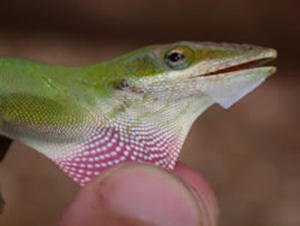
Caption
Male anole lizards have neck fans called dewlaps that expand to mark their territory.
Credit: J. D. Willson / UGA
Green anole lizards are native to the southeastern U.S., but they thrive particularly well in Georgia and South Carolina along the Savannah River that runs from the foothills to the coast.
The species Anolis carolinensis can grow to more than six inches long and is characterized by its neon green body color, which changes to brown in times of stress. The lizard is also known for its pigmented neck skin, which becomes bright red or pink when males expand a 'dewlap' — an air pouch similar to a pelican's throat pouch—to mark their territory.
Although the lizard changes colors, it is not a true chameleon, according to the University of Georgia's Savannah River Ecology Laboratory. The green anole is the only anole species native to the U.S., although several other species have been introduced in Florida and are expanding their ranges northward.
A herpetology brief from UGA and a website for wildlife experts warned of challenges from species such as the Cuban anole: "It is uncertain how the green anole will fare when forced to compete with these similar species."

Male anole lizards have neck fans called dewlaps that expand to mark their territory.
Anoles are carnivorous and live on insects, spiders and other invertebrates. They are active in warm weather and like to sunbathe on railings, patios, sidewalks and decks. Green anoles are found in urban and suburban areas throughout Georgia, but generally not in mountainous regions.
The lizards are cute, but will bite humans if caught or cornered. Late night TV host Stephen Colbert, who's originally from South Carolina, used an on-air segment to demonstrate the bite of the green anole. Although the species is not venomous, these animals can transmit diseases.
Because green anoles are generally harmless to pets and people, farmer's almanacs recommend adding these lizards to your garden if caterpillars, moths, flies, beetles, grasshoppers, or other insects become problematic.